Family name: Musaceae A.L. Jussieu
Synonym(s): [none]
Common name(s): banana family
*Number of genera/species: 2/91
List of genera records in GRIN-Global
fruit or seed
Fruit a berryberry:
an indehiscent, fleshy fruit with one or a few to many seeds. The flesh may be homogenous throughout. Or, if the outer part is hard, firm, or leathery, referred to as an hesperidium. Septa are present in some, and the seeds may be arillate or with a fleshy testa.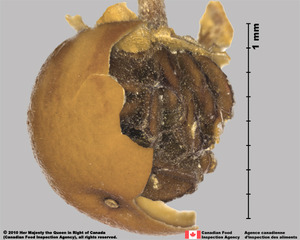 , rarely dehiscentdehiscent:
, rarely dehiscentdehiscent:
(v. dehisce) splitting open at maturity to release contents (of a fruit)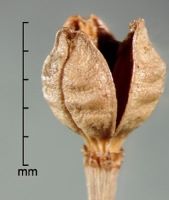 by decay, 30–140 mm long, tereteterete:
by decay, 30–140 mm long, tereteterete:
approximately circular in cross section; width and thickness approximately equal
 or angledangular:
or angledangular:
2D shape—having sides that meet at acute or obtuse angles
in transection, beakedbeak:
a usually firm, terminal appendage, sometimes tapered , sometimes perianthperianth:
, sometimes perianthperianth:
collective term for calyx and corolla of a flower
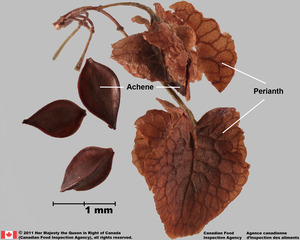 persistent, with few or many seeds. Pericarppericarp:
persistent, with few or many seeds. Pericarppericarp:
fruit wall or fruit coat
black, gray, purple, orange, red, yellow, yellow-green, or green, dulldull:
reflecting only a low proportion of incident light, with no apparent sheen , leatheryleathery:
, leatheryleathery:
texture—moderately thick, tough, and very pliable
, slightly to prominently ridgedridged:
surface relief—raised, thick ridges, sharp edged or rounded, usually in a series that may cover the entire surface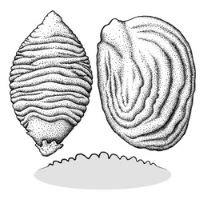 , sometimes pubescentpubescent:
, sometimes pubescentpubescent:
surface relief—bearing hairs
. Mesocarpmesocarp:
the middle layer of the pericarp, if divided into layers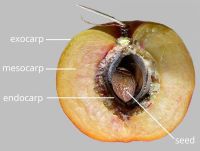 fibrousfibrous:
fibrousfibrous:
texture—long, flexible threads, thicker than hairs, that densely cover and obscure the surface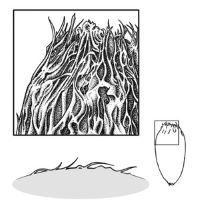 or fleshy and starchy.
or fleshy and starchy.
Seeds globoseglobose:
3D shape—more or less spherical to lens-shapedlens-shaped:
to lens-shapedlens-shaped:
2D shape—round and flattened with two curved (convex) surfaces
, compressedcompressed:
flattened; in grasses, used to denote compression (not necessarily flattened) either laterally or dorsiventrally
in transection, 1–15 mm long, operculateoperculum:
a dehiscent cap (or lid) of a seed or fruit that opens during germination or dehiscence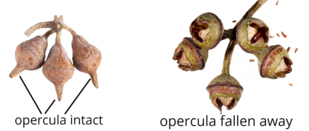 , with double micropylar collarmicropylar collar:
, with double micropylar collarmicropylar collar:
collar shaped tissue at micropyle
. Hilumhilum:
on seeds, the scar indicating where the funiculus was attached; on grass caryopses, the scar visible on the outer fruit surface revealing where the seed is attached on the inner fruit wall surface; or in Asteraceae cypselae, the scar visible on the outer fruit wall revealing where the fruit was attached to the receptacle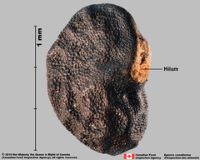 conspicuous, irregular, and often sunken. Seed coat blue, black, or brown, dulldull:
conspicuous, irregular, and often sunken. Seed coat blue, black, or brown, dulldull:
reflecting only a low proportion of incident light, with no apparent sheen , bonybony:
, bonybony:
very hard and rather brittle, like bone
and thick, smooth, reticulatereticulate:
surface relief—netted, raised walls or concave grooves forming a net-like surface pattern with flat, concave, or convex interspaces , roughenedroughened:
, roughenedroughened:
texture—having a small, stout, stiff, more or less acute protrusions
, wartywarty:
surface relief—distinct, rounded projections that are large relative to the fruit size; tuberculate, verrucose , wrinkledwrinkled:
, wrinkledwrinkled:
surface relief—shallow, irregular folds and furrows covering the surface; appearing overall though crumpled and then spread out , or papillatepapillate:
, or papillatepapillate:
surface relief—bearing minute, distinct, broad-based projections, tapering to a rounded apex .
.
Embryo well developed, linearlinear:
(shape) long, narrow, and uniform in width; (of embryo) embryo is straight and much longer than wide or capitatecapitate:
or capitatecapitate:
head-shaped; abruptly enlarged on one end to a relatively short, terminal portion
, straight or slightly curvedcurved:
(of embryo) linear embryo is curved into an arch or horseshoe with the ends far apart (Ensete).
(Ensete).
Endosperm copious, starchy, and mealymealy:
loose, dry, and disintegrating in finely granular
pieces like meal or flour
. Thin layer of perispermperisperm:
seed nutritive tissue comparable to the endosperm, but derived from the nucellus (maternal tissue)
also present.
| Fruit | |
| Type | berryberry: an indehiscent, fleshy fruit with one or a few to many seeds. The flesh may be homogenous throughout. Or, if the outer part is hard, firm, or leathery, referred to as an hesperidium. Septa are present in some, and the seeds may be arillate or with a fleshy testa.  |
| Size range | 30–140 mm long |
| Shape(s) | ellipsoidellipsoid: 3D shape—elliptic , cylindricalcylindrical: 3D shape—a cylinder, with parallel sides and a circular cross-section; tubular or rod-shaped , triangulartriangular: 2D shape—three relatively straight sides with distinct corners; more angular than teardrop-shaped  , ovoidovoid: , ovoidovoid:3D shape—ovate  , angularangular: , angularangular:2D shape—having sides that meet at acute or obtuse angles , trigonoustrigonous: 3D shape—having three faces that meet at distinct angles; triangular in outline , cuneiformcuneiform: wedge-shaped , oblongoblong: 2D shape—much longer than broad with nearly parallel sides, corners are rounded  , fusiformfusiform: , fusiformfusiform:spindle-shaped; broadest at the middle and tapering at both ends 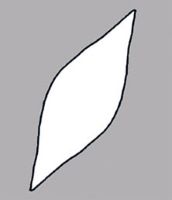 |
| Texture | leatheryleathery: texture—moderately thick, tough, and very pliable |
| Surface relief | ridgedridged: surface relief—raised, thick ridges, sharp edged or rounded, usually in a series that may cover the entire surface  |
| Color(s) | black, gray, purple, orange, red, yellow, yellow-green, green |
| Unique features | Beakedbeak: a usually firm, terminal appendage, sometimes tapered  , leatheryleathery: , leatheryleathery:texture—moderately thick, tough, and very pliable berriesberry: an indehiscent, fleshy fruit with one or a few to many seeds. The flesh may be homogenous throughout. Or, if the outer part is hard, firm, or leathery, referred to as an hesperidium. Septa are present in some, and the seeds may be arillate or with a fleshy testa.  with seeds enclosed within a fleshy, starchy pulp. with seeds enclosed within a fleshy, starchy pulp. |
| Seed | |
| Size range | 1–15 mm long |
| Shape(s) | globoseglobose: 3D shape—more or less spherical  , irregular, oblateoblate: , irregular, oblateoblate:depressed globose , lens-shapedlens-shaped: 2D shape—round and flattened with two curved (convex) surfaces , conicalconical: 3D shape—cone-shaped, with the point of attachment at the broad end 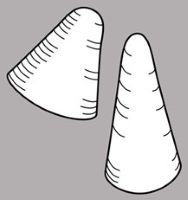 |
| Surface relief | smooth, reticulatereticulate: surface relief—netted, raised walls or concave grooves forming a net-like surface pattern with flat, concave, or convex interspaces  , roughenedroughened: , roughenedroughened:texture—having a small, stout, stiff, more or less acute protrusions , wartywarty: surface relief—distinct, rounded projections that are large relative to the fruit size; tuberculate, verrucose  , wrinkledwrinkled: , wrinkledwrinkled:surface relief—shallow, irregular folds and furrows covering the surface; appearing overall though crumpled and then spread out  , papillatepapillate: , papillatepapillate:surface relief—bearing minute, distinct, broad-based projections, tapering to a rounded apex  |
| Color(s) | black, blue, brown |
| Unique features | Large, dark seeds with operculaoperculum: a dehiscent cap (or lid) of a seed or fruit that opens during germination or dehiscence  and double micropylar collarsmicropylar collar: and double micropylar collarsmicropylar collar:collar shaped tissue at micropyle , usually with sculptured seed coats. |
| Other | |
| Embryo | well developed, linearlinear: (shape) long, narrow, and uniform in width; (of embryo) embryo is straight and much longer than wide  or capitatecapitate: or capitatecapitate:head-shaped; abruptly enlarged on one end to a relatively short, terminal portion , straight or slightly curvedcurved: (of embryo) linear embryo is curved into an arch or horseshoe with the ends far apart  (Ensete) (Ensete) |
| Nutritive tissue | endosperm copious, starchy and mealymealy: loose, dry, and disintegrating in finely granular pieces like meal or flour ; thin layer of perispermperisperm: seed nutritive tissue comparable to the endosperm, but derived from the nucellus (maternal tissue) also present |
Paleotropics, Northern Australia.

Distribution map courtesy of Angiosperm Phylogeny Website.
Baskin and Baskin 2021Baskin and Baskin 2021:
Baskin C and Baskin J. 2021. Relationship of the lateral embryo (in grasses) to other monocot embryos: A status up-grade. Seed Science Research 31 (3): 199-210. doi:10.1017/S0960258521000209; Dahlgren et al. 1985Dahlgren et al. 1985:
Dahlgren RMT, Clifford HT, and Yeo PF. 1985. The families of the monocotyledons: structure, evolution, and taxonomy. Springer-Verlag, Berlin. 520 pp.; Davidse et al. 2009–2018Davidse et al. 2009–2018:
Davidse GM, Sousa Sánchez M, Knapp S. and Chiang Cabrera F, eds. 2009–2018. Flora Mesoamericana. Missouri Botanical Garden, St. Louis, MO. Accessed: January–April 2024. URL: http://legacy.tropicos.org/Project/FM; Flora of Australia 2021+Flora of Australia 2021+:
Flora of Australia. Australian Biological Resources Study, Canberra. Accessed January 2021–March 2024. URL: http://www.ausflora.org.au; Kirkbride et al. 2006Kirkbride et al. 2006:
Kirkbride JH, Jr, Gunn CR, and Dallwitz MJ. 2006. Family guide for fruits and seeds, vers. 1.0. Accessed September 2020-January 2022. URL: https://nt.ars-grin.gov/seedsfruits/keys/frsdfam/index.cfm .; Kubitzki et al. 1990+Kubitzki et al. 1990+:
Kubitzki K et al., eds. 1990+. The families and genera of vascular plants. 7+ vols. Berlin etc.; Stevenson and Loconte 1995Stevenson and Loconte 1995:
Stevenson DW and Loconte H. 1995. A cladistic analysis of monocot families. In: Rudall PJ, Cribb PJ, Cutler DF, and Humphries CJ, eds. Monocotyledons: Systematics and Evolution. Royal Botanic Gardens, Kew.; Watson and Dallwitz 1992+Watson and Dallwitz 1992+:
Watson L and Dallwitz MJ. 1992+. The families of flowering plants: descriptions, illustrations, identification, and information retrieval. Version: 6th Accessed September 2020-September 2022. URL: delta-intkey.com; Zhengyi et al. 2004+Zhengyi et al. 2004+:
Zhengyi W, Raven PH, and Deyuan H. 2004+. Flora of China [online]. 25 vols. Science Press, Beijing China & Missouri Botanical Garden, St. Louis USA. Accessed January–March 2024. http://flora.huh.harvard.edu/china/
*The number of genera and species is based on Christenhusz and Byng 2016Christenhusz and Byng 2016:
Christenhusz MJM and Byng JW. 2016. The number of known plant species in the world and its annual increase. Phytotaxa 261 (3): 201-217. https://doi.org/10.11646/phytotaxa.261.3.1, which may differ from the number of genera in GRIN-Global.